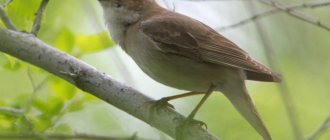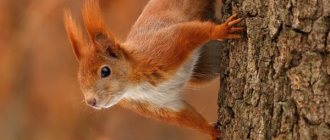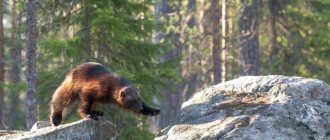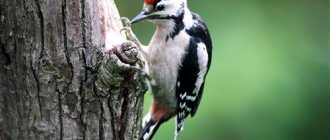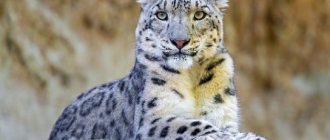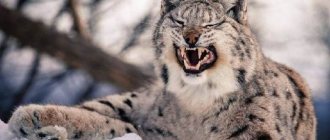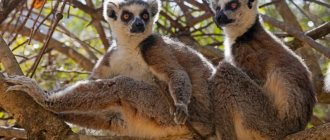Polar bear
When the North Pole is mentioned, the first animal that comes to mind is the polar bear. This predator reaches a weight of one ton and a length of up to 3 meters. The bear eats mainly walruses and seals, but sometimes it manages to feast on whales that the sea washes ashore. Polar bear meat is poisonous and can only be eaten in small quantities. They are also listed in the Red Book.
Polar bear
Polar bears are dangerous to humans, so you need to be careful in places where they potentially appear. Food waste attracts these animals, so in northern communities it is important to limit the number of landfills, especially with free access.
Amazing birds
The cold region with a harsh climate called the Arctic surprises with its diversity of fauna. Birds also found their place on this piece of land.
White Owl
A very beautiful bird. This is a harsh predator that is constantly in flight for prey. The wingspan of an owl can reach up to 1.5 meters. Males are smaller in size than females and have a distinctive feature in the form of black specks. The eyes are yellow, the ears are so small that they are not visible. The beak is black, but completely hidden under the plumage.
Long claws help them hunt and perch comfortably on elevated places. The diet consists of small mammals.
Interesting fact! In times when there is not enough food, owls stop breeding for this time and fly closer to the southern regions.
Pink seagull
Despite the strong cold winds, this small bird has found its home in the Arctic. It builds nests on the shores of the ocean. The seagull is no more than 35 cm long and weighs only 250 grams. The head is pale pink, and the back and wings are gray. The paws are bright red, and on her neck there is a black collar, which disappears with the onset of severe cold. Swims well in water and can sometimes land on ice floes. It feeds mainly on small insects, fish, crustaceans and mollusks. These fragile birds are often targeted by predators. They are hunted by Arctic foxes and reindeer.
Lyurik
The little auk is the second name for these birds. They nest in high latitudes. Little auks are the most mobile and smallest inhabitants of the Arctic among birds.
They move on land very deftly and quickly. They also feel confident at sea. Great maneuverability and frequent flaps during flight resemble a large insect rather than a bird. The color of the plumage resembles a tailcoat.
Arctic animals are in a daily struggle for life. Natural selection is cruel. Despite this, the northern region shelters a variety of fauna on its land.
Walrus
This marine mammal feeds on shellfish and fish. Sometimes it eats seal meat or carrion. Their mass can be a whole ton. The thick-skinned animals of the north are famous for their tusk fangs. They can weigh 5 kilograms and reach a length of up to a meter. Young walruses have darker skin coloring than adults. They can stay under water for a maximum of 10 minutes. Walruses are sociable and live in packs, protecting each other from various misfortunes.
Walrus
Mammals
The vast expanses of the harsh Arctic are characterized by snow-covered deserts, very cold winds and permafrost. Precipitation in such areas is very rare, and sunlight may not penetrate the darkness of the polar nights for several months. Mammals existing in such conditions are forced to spend a difficult winter period among the scorching cold of snow and ice.
Arctic fox or arctic fox
Small representatives of the fox species (Alopex lagopus) have long inhabited the Arctic. Predators from the Canidae family resemble a fox in appearance. The average body length of an adult animal varies between 50-75 cm, with a tail length of 25-30 cm and a height at the withers of 20-30 cm. The body weight of a mature male is approximately 3.3-3.5 kg, but the weight of some individuals reaches 9.0 kg. Females are noticeably smaller. The Arctic fox has a squat body, a short muzzle and rounded ears that protrude slightly from the fur, which prevents frostbite.
White or polar bear
The polar bear is a northern mammal (Ursus maritimus) from the Bear family, a close relative of the brown bear and the largest land predator on the planet. The body length of the beast reaches 3.0 meters and weighs up to a ton. Adult males weigh approximately 450-500 kg, and females are noticeably smaller. The height of the animal at the withers most often varies between 130-150 cm. Representatives of the species are characterized by a flat head and a long neck, and translucent hairs are capable of transmitting only UV rays, which gives the predator’s coat thermal insulation properties.
It will be interesting: why are polar bears white?
Leopard seal
Representatives of the species of true seals (Hydrurga leptonyx) owe their unusual name to their original spotted skin and very predatory behavior. The leopard seal has a streamlined body that allows it to develop very high speeds in water. The head is flattened, and the forelimbs are noticeably elongated, due to which movement is carried out with strong synchronized strikes. The body length of an adult animal is 3.0-4.0 meters. The upper part of the body is dark gray in color, while the lower part is silvery-white. There are gray spots on the sides and head.
Bighorn sheep, or chubuk
Artiodactyl (Ovis nivicola) belongs to the genus of sheep. Such an animal has a medium size and a dense build, a thick and short neck, as well as a small head with rather short ears. The ram's limbs are thick and not high. The body length of adult males is approximately 140-188 cm, with a height at the withers ranging from 76-112 cm and a body weight of no more than 56-150 kg. Adult females are slightly smaller than males. Diploid cells in representatives of this species contain 52 chromosomes, which is less than in any other modern species of sheep.
Muskox
A large hoofed mammal (Ovibos moschatus) belongs to the musk ox genus and the Bovid family. The height of adult individuals at the withers is 132-138 cm, with a weight ranging from 260-650 kg. The weight of females most often does not exceed 55-60% of the weight of the male. The musk ox has a hump-like scruff in the shoulder area, which turns into a narrow rear part. The legs are small, stocky, with large and rounded hooves. The head is elongated and very massive, with sharp and rounded horns, which grow in the animal until the age of six. The hairline is represented by long and thick hair, which hangs almost to ground level.
Arctic hare
The hare (Lepus arcticus), formerly considered a subspecies of the mountain hare, but today recognized as a separate species. The mammal has a small and fluffy tail, as well as long, powerful hind legs, which allow the hare to easily jump even on high snow. Relatively short ears help reduce heat transfer, and abundant fur allows the northern inhabitant to easily tolerate very severe cold. Long and straight incisors are used by the hare to feed on sparse and frozen arctic vegetation.
Weddell seal
A representative of the family of true seals (Leptonychotes weddellii) is a not very widespread and rather large in body size predatory mammals. The average length of an adult is 3.5 meters. The animal is able to stay under the water for about an hour, and the seal obtains food in the form of fish and cephalopods at a depth of 750-800 meters. Weddell seals quite often have broken fangs or incisors, which is explained by the fact that they make special holes through young ice.
Wolverine
The predatory mammal (Gulo gulo) belongs to the mustelidae family. This rather large animal is second only to the sea otter in size in the family. The weight of an adult is 11-19 kg, but females are slightly smaller than males. The body length varies between 70-86 cm, with a tail length of 18-23 cm. In appearance, the wolverine is most likely similar to a badger or a bear with a squat and awkward body, short legs and an arched upward back. A characteristic feature of the predator is the presence of large and hooked claws.
Return to content
Seal
Seals are cute creatures. There are 20 species of them, one of which is the elephant seal, weighing 2500 kilograms. They can also smell odors from 200-500 meters away. These pinnipeds of the north give birth to only one baby at a time, but it is very strong and healthy. Despite the fact that seals do not have ears, they hear quite well. In addition, seals have poor echolocation skills, which they use to find prey underwater.
Seal
Reptiles and amphibians
The harsh climatic conditions of the Arctic do not allow various cold-blooded animals, including reptiles and amphibians, to spread as widely as possible. At the same time, the northern territories have become quite suitable habitat for four species of lizards.
Viviparous lizard
The scaly reptile (Zootoca vivipara) belongs to the family True lizards and the monotypic genus Forest lizards (Zootoca). For some time, such a reptile belonged to the genus Green lizards (Lacerta). A well-swimming animal has a body size of 15-18 cm, of which approximately 10-11 cm is in the tail. The body color is brown, with dark stripes that stretch along the sides and in the middle of the back. The lower part of the body is light in color, with a greenish-yellowish, brick-red or orange tint. Males of the species have a slimmer build and brighter colors.
Siberian newt
The four-toed newt (Salamandrella keyserlingii) is a very striking representative of the salamander family. An adult tailed amphibian has a body size of 12-13 cm, of which less than half is in the tail. The animal has a wide and flattened head, as well as a laterally compressed tail, which is completely devoid of leathery fin folds. The color of the reptile has a grayish-brown or brownish color with the presence of small spots and a fairly light longitudinal stripe in the back area.
Semirechensky frogtooth
The Djungarian newt (Ranodon sibiricus) is a tailed amphibian from the salamander family (Hynobiidae). An endangered and very rare species today, its body length ranges from 15-18 cm, but some individuals reach sizes of 20 cm, of which the tail part occupies a little more than half. The average body weight of a sexually mature individual can vary between 20-25 g. On the sides of the body there are from 11 to 13 intercostal and clearly visible grooves. The tail part is laterally compressed and has a developed fin fold in the dorsal area. The color of the reptile varies from yellow-brown to dark olive and greenish-gray, often with spots.
tree frog
The tailless amphibian (Rana sylvatica) is capable of freezing to the point of ice in the harsh winter. An amphibian in this state does not breathe, and the heart and circulatory system stop. When the weather gets warmer, the frog “thaws out” quite quickly, which allows it to return to normal life. Representatives of the species are distinguished by large eyes, a clearly triangular-shaped muzzle, and a yellow-brown, gray, orange, pink, brown or dark gray-green dorsal area. The main background is supplemented with blackish or dark brown spots.
Return to content
killer whale
There is a lot to be said about the killer whale, the main enemy of seals. This cetacean, as you can already understand, primarily feeds on seals, but there are also species that eat herring. Killer whales are the largest carnivores of the dolphin family. This animal of the north can weigh 8 tons and reach 10 meters in length. The teeth are long, as much as 11 centimeters in length. You can take a ruler and see how big their teeth are. The name killer whale in English translates to killer whale.
killer whale
Arctic hare
The Arctic hare is without a doubt one of the most charming cold-loving animals. Unlike some other animals, hares do not hibernate in winter. Instead, they adapted to the tundra thanks to their thick fur and short ears.
We also recommend reading: Photo of Ranevskaya
In winter, their fur turns a snow-white color that matches the snow. However, in the spring it turns grayish-blue to blend in with the rocks and other surrounding vegetation.
Because arctic hares are frequent prey for predatory animals, they have adapted for speed and agility in ice and snow. Often reaching speeds of 65 kilometers per hour!
Arctic hares feed on roots, berries, mosses and other vegetation and were once a vital source of food and clothing for northern peoples.
Arctic fox
A small predatory animal, the arctic fox, lives at the North Pole. This nimble northern animal can change its color depending on the time of year. The arctic fox looks like a fox and it is no coincidence: its other name is polar fox. It feeds on fish, lemmings and even birds.
Arctic fox
Features of animals in cold areas of the world
The fauna of the northern regions of the world differs significantly from their counterparts from the south - they have incredibly dense fur with an undercoat that retains heat. Subcutaneous fat is another integral attribute of most inhabitants of the poles.
Some animals, such as walruses and narwhals, have huge teeth and tusks that help them move across thick ice and sometimes chop it.
If you go a little lower, to regions where the temperature rarely drops below -50 degrees (for example, in the Siberian tundra), then the animals will have less fat. However, they retain fine fur with an undercoat - usually gray or snow-white.
Lemming
This small northern animal is very similar to a hamster both in appearance and in its lifestyle. The rodent feeds on sedge, mosses and tundra shrubs. Lemmings reproduce quickly: the female gives birth to 4-5 litters of up to 12 babies per year. It is also believed that lemmings can commit mass suicide by jumping off cliffs. And it’s true that the number of lemmings sometimes decreases noticeably.
Lemming
Spiders
Arachnids are obligate predators that demonstrate the highest potential for mastering the complex Arctic environment. The Arctic fauna is represented not only by a significant number of boreal spider forms coming from the southern part, but also by purely Arctic species of arthropods - hypoarcts, as well as hemiarcts and evarcts. Typical and southern tundras are rich in a wide variety of spiders, differing in size, hunting method and biotopic distribution.
Oreoneta
Representatives of the genus of spiders belonging to the family Linyphiidae. This arachnid arthropod was first described in 1894, and today about three dozen species are classified in this genus.
Masikia
Representatives of the genus of spiders belonging to the family Linyphiidae. The first inhabitant of the Arctic territories was described in 1984. Currently, only two species are classified in this genus.
Tmetits nigriceps
A spider of this genus (Tmeticus nigriceps) lives in the tundra zone, is distinguished by an orange-colored prosoma, with the presence of a blackish-cephalic region. The spider's legs are orange, and the opisthosoma is black. The average body length of an adult male is 2.3-2.7 mm, and that of females is between 2.9-3.3 mm.
Gibothorax tchernovi
The spin species, belonging to the taxonomic classification Hangmatspinnen (linyphiidae), belongs to the arthropod arachnids of the genus Gibothorax. The scientific name of this species was first published only in 1989.
Perrault Polaris
One of the currently insufficiently studied species of spiders, first described in 1986. Representatives of this species are classified in the genus Perrault, and are also included in the family Linyphiidae.
sea spider
Sea spiders have been discovered relatively recently in the polar Arctic and in the waters of the Southern Ocean. Such aquatic inhabitants are gigantic in size, and the length of some of them exceeds a quarter of a meter.
Return to content
Pink seagull
This bird is not very large, but lives well in the harsh conditions of the north. Her body length is 35 centimeters, she weighs only a quarter of a kilogram. Listed in the Red Book. The pink gull is a nomadic bird. It feeds on mollusks, insects and, of course, fish.
Two pink gulls
polar owl
Another predator of the tundra is the polar owl. She is the most formidable and largest of the carnivorous birds there. Females are larger than males and reach 70 centimeters in length and weigh up to 3 kilograms.
polar owl
This harsh bird of the north hunts partridges and lemmings, and sometimes eats small predators. The snowy owl kills more than 1,600 lemmings per year. Arctic foxes, whose owls steal their cubs, in turn eat their eggs.
Snow goats
This artiodactyl mammal, covered with thick white fur, lives high in the mountains. Snow goats have small, backward-curved horns. Their body length can reach 180 cm, females are slightly smaller than males. Weight from 60 to 130 kg. They live mainly in western North America, in the mountains of Montana, Alaska and Idaho. Also inhabits the mountains of Canada. Easily tolerates frosts down to -40 degrees Celsius.
